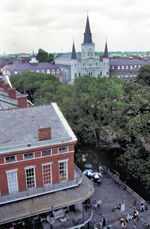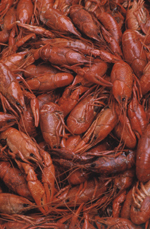 |
The St. Louis Cathedral and the Pontalba building frame Jackson Square in the French Quarter. |
Tulane students find that the city of New Orleans is a source of learning and intellectual challenge. “The test of a first-rate intelligence,” wrote F. Scott Fitzgerald, “is the ability to hold two opposed ideas in mind at the same time, and still retain the ability to function.” New Orleans can offer such a test, for in few American cities today do the past and the future unite so intensely.
New Orleans was founded because of its location near the mouth of the Mississippi River. As a port and strategic outpost, the area has played an important role in American history and the economy.
Governed in the past by the French and the Spanish, the city still expresses this European influence in its architecture, food, and way of life. Mixed with these cultural elements and the strong African, Cajun, Caribbean, Creole and traditions are newer influences to the community: German, Greek, Irish, Italian, Spanish, and Vietnamese peoples who have brought new diversity to the city. These added components increase the diversity of the city’s rich historical and cultural heritage, combining the best of the Old World with the New.
 |
| Many spring social activities revolve around crawfish boils. Crawfish, or "mudbugs" are in season from about March - June. |
New Orleans is a city of local delights. New Orleanians are fascinated by their food, a cuisine enriched by the African, French, Indian, and Spanish cultures. The wonder of the food is that it can be excellent not only in the well-known restaurants of the French Quarter but in dozens of lesser-known neighborhood restaurants as well. New Orleans’ music is as distinctive as its cuisine. It is the hometown of not just Jelly Roll Morton and Louis Armstrong, but Fats Domino, Irma Thomas, the Marsalis family, the Neville Brothers, and Lee Dorsey. All of these local delights are known and loved all over the world but are at their best at home.
This rich mixture of history is celebrated often and heartily, most notably in the great street festival and social pageant known as Mardi Gras. Carnival lasts two weeks, but its spirit lingers through the year. Mardi Gras beads hang from car mirrors, balconies, and every other conceivable location. The city also takes pride in its symphony orchestra, opera, art museums, theaters, professional sports, zoo, aquarium, and attractions uniquely its own, such as Jazz Fest, sailing on Lake Pontchartrain, riverboats on the Mississippi, and late night cups of cafe au lait.
New Orleanians cultivate their capacity to enjoy their own physical and cultural environment. If it is possible to learn that kind of appreciation, New Orleans is the place to do it.
|

